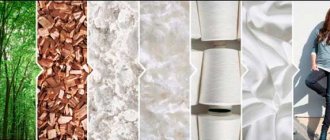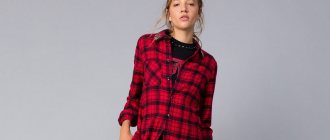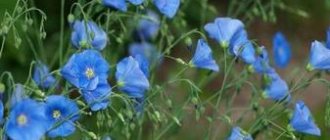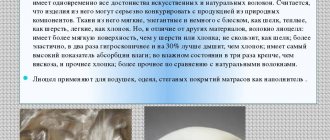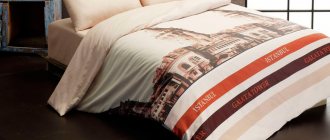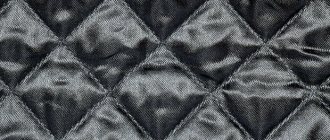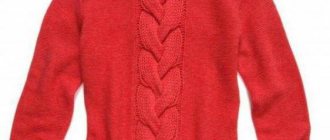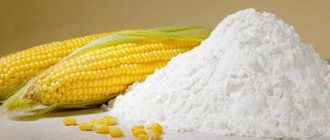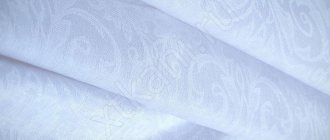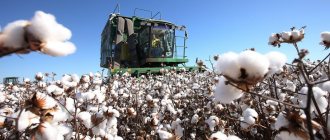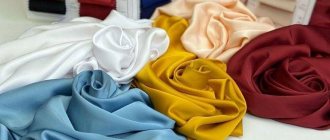Blankets filled with lyocell combine the best qualities of bedding made from natural and artificial materials. The innovative fiber is completely natural - made from wood pulp of oak, birch, and beech. But the most valued is lyocell made from eucalyptus, a tropical species with unique bactericidal and healing properties. Eucalyptus fiber is deservedly considered one of the new generation of environmentally friendly fillers - you can sleep wonderfully under such a blanket, moreover, it successfully fights many bacteria and gives a feeling of comfort.
What is lyocell
A relatively recently invented artificial material can rightfully be called a product of nanotechnology. In the production of lyocell, the organic synthesis of cellulose extracted from eucalyptus fibers with N-methylmorpholine N-oxide is carried out. The chemically produced fiber is characterized by high strength and wear resistance, and is used in the production of cables, protective covers, and automobile filters. Safe to use, widely used by light industry for the manufacture of summer clothing, linen, and children's items.
History of creation
The evolution of scientific knowledge from the discovery of cellulose to the creation of lyocell lasted 1.5 centuries. French scientist Anselm Payen first announced the existence of a white solid organic compound with molecules that look like long, unbranched chains in 1838. It turned out that this substance is the basis of various plant fibers, including cotton. 54 years later, a method for producing cellulose from wood was patented, and after another 95 years, cellulose itself became the basis of an elite fabric, not inferior in quality to cotton, silk, and wool.
Fabric brands
Britain's largest fabric and clothing manufacturer was Courtaulds, founded in 1794 by cousins George Courtauld and Peter Taylor. In 1904, in order to reduce dependence on natural raw materials, the company acquired patents for the production of artificial silk from cellulose. The material, obtained by dissolving wood pulp in a mild co-oxidizer, is called Tencel. Today, production is located in the USA, carried out by Lenzing, and Tencel is one of the most famous commercial names of lyocell.
At the World Exhibition of Viscose Silk in 1900, D.I. Mendeleev proposed producing artificial fibers in Russia, after which a small production facility was created in Mytishchi near Moscow. Today, the All-Russian Research Institute of Polymer Fibers (VNIIPV) on the basis of this plant produces lyocell, known under the brand name Orcel.
Lyocell production
A significant advantage of Lyocell over viscose is safe production. A mild oxidizing agent that dissolves wood to produce cellulose is non-toxic, does not decompose into harmful substances during production, and does not produce hazardous waste. Schematically, the technological chain for producing lyocell can be divided into four stages:
- Dissolving eucalyptus cellulose:
- the wood is crushed to form a powder;
- the resulting powder is diluted with methylmorpholine oxide;
- the mixture is heated to 100 degrees Celsius;
- the hot solution is placed in a bath to cool and settle;
- Filtration of the solution;
- Tissue formation is carried out in two stages:
- the fibers are pulled in the longitudinal direction;
- carry out desolvation and crystallization of the fibers to obtain the finished thread;
- Subsequent processing: dyeing, drying, plain weaving, etc.
Unique fabric properties
Lyocell combines the best qualities of natural and artificial materials, and this could not but affect the cost. Products with 100% content are classified as expensive, so the market is mostly represented by products that combine lyocell with elastane at different percentages. The properties of lyocell fabric are impressive:
- increased strength: does not tear under strong impact in dry and wet conditions;
- high fabric density ensures high wear resistance;
- hygroscopicity: absorbs moisture well and quickly evaporates it when drying;
- hypoallergenic: the fiber structure prevents the accumulation of dust and the appearance of bacteria;
- high degree of breathability: the fabric “breathes”, helping to maintain normal body temperature in hot weather;
Properties of Lyocell
What properties is endowed with lyocell after manufacturing:
Fiber production process
- Lyocell is a fabric that does not deform at all.
- Endowed with hygroscopicity. Not suitable enough for creating outerwear, but, for example, 100 lyocell (bandages) are used in medicine.
- The fabric is hypoallergenic and protects people who have irritation from synthetics. Products made from fabric with the addition of lyocell are recommended to be worn by both children and adults.
- Repels dust - this is one of people's favorite qualities.
- The material is quite breathable, which is why pillows, bedspreads and mattresses began to be made from it.
You might be interested in Features of crepe georgette: fabric properties
Natural or artificial fabric
To understand what kind of fabric lyocell is, natural or artificial, you need to know the raw materials from which it is made.
Finished eucalyptus fiber
The raw material is extracted from eucalyptus leaves through the synthesis of cellulose fiber. The origin of the material is artificial, but endowed with rare features.
The fabric has better characteristics than natural cotton. In the description of the material, it is necessary to emphasize: the density, hypoallergenicity and protective properties that eucalyptus wood has. The yarn is universal; it can be used to make fabrics or filler.
Advantages and disadvantages of lyocell
The demand for products made from lyocell is constantly growing, this is easily explained: the material is beautiful, easy to use, more practical than many cotton fabrics, strong, useful and durable. Many of its beneficial properties are inherited from eucalyptus, from the wood of which it is produced. The list of its advantages significantly exceeds the list of disadvantages, these include:
- pleasant to the touch, comfortable to use;
- retains its original appearance and shiny surface for a long time;
- presented in a wide range of wash-resistant colors;
- stretches well, hugging the figure;
- retains its shape during use for a long time;
- does not form pills, is easy to iron;
- has bactericidal properties;
- does not cause allergies.
The disadvantages include:
- high price;
- shrinks slightly when washed;
- the ability to absorb moisture is not always an advantage.
- How to print text from a computer to a printer
- How to get through a person's cell phone number
- Use of cinnamon for diabetes
Comparison of Lyocell with other fibers
Many people believe that lyocell will soon displace fabrics such as cotton or chintz from the market. It has already gained its popularity in Russian markets due to the fact that it is excellent for people with allergies. And the high price only creates great demand for these materials, as people understand that they are paying for good quality. Lyocell clothing is great for hot and sultry summers because it is well ventilated.
Color options
Attention! Lyocell material has the characteristics of silk, wool and cotton at the same time.
Therefore, shirts, trousers, T-shirts or dresses are made from it. But it is important to take proper care of the fabric.
Application of material
Having information about what is good about lyocell - what kind of fabric it is, what the main properties of the fiber are, it’s time to figure out what areas this material is used for. Initially, a silk-like fabric with excellent consumer qualities was in demand only in the production of clothing. The spectacular appearance of the canvas after applying bright thematic prints suggested the idea of producing luxury bed linen from eucalyptus fiber yarn. After some time, Lyocell fiber began to be used as a filler for pillows and blankets.
Lyocell bed linen
Canvas made of eucalyptus fibers is a material that has the consumer appearance of silk, and the strength of cotton. This circumstance marked the beginning of its use in the production of luxury bed linen. Lyocell sleeping sets are practical and can withstand a large number of washes without losing quality or appearance. They are soft, delicate, silky, slightly cooling and, importantly, hypoallergenic. The cost of such linen is high, but products combining eucalyptus fibers with cotton or silk are quite affordable.
Lyocell filler in pillows and blankets
The hypoallergenic and bactericidal effect that eucalyptus fibers have is the main reason for using them as bedding filler. Pillows, blankets, mattresses with lyocell retain their shape and elasticity for a long time, do not roll down, and allow air to pass through. They do not produce pathogenic microflora; this is an excellent option for people suffering from allergies. To reduce the cost of such products, they use a filler made from a mixture of eucalyptus fibers and holofiber.
Cloth
Lyocell is most widely used in the production of clothing. Products made from it are softer than those made from natural materials, stretch, hold their shape well, and do not form pills. The range of clothing items made from eucalyptus fiber yarn is wide - from children's dressing gowns to evening dresses and suits. The high strength of the material allows the production of men's and women's trousers and jeans. Turtlenecks and polo shirts made from eucalyptus fiber yarn are very popular. The products last a long time, are hygienic, and require little maintenance.
Some facts from the history of lyocell
Blankets filled with lyocell began to be produced not so long ago, because the material itself was invented in 1988, and the first large batch of innovative fiber called Tencel was produced by the American company Courtaulds Fibres in 1992. In parallel with the Courtaulds chemists, another company was developing new cellulose textiles from the USA – Enka. It was in 1992 that the current leader in filler production, the Austrian concern Lenzing AG, bought the Tencel production technology from her. In 1996, the Austrians patented a new name for the innovative fiber - lyocell (lyocell). In Russia, similar material is produced under the Orcel brand.
Unlike the cultivation of cotton and flax, during which pesticides and herbicides are actively used, lyocell is made from wood raw materials using waste-free, environmentally friendly technologies. Numerous EU certificates and awards from European environmental organizations testify to the uncompromising uniqueness of tencel cellulose fiber (lyocell, orcell), its absolute harmlessness to the health of both adults and children.
Lyocell production technology is constantly being improved to meet growing consumer demands. Quite recently, blankets with a new filling, combined from tencel and seaweed, have appeared on sale. Air iodization and antioxidant effect have been added to the beneficial properties of artificial fiber.
- Lyocell quality
Lyocell duvet filling is a soft, warm and lightweight fiber. Possessing extraordinary softness, it is a natural antiseptic - it prevents the spread of pathogenic microorganisms, has a beneficial effect on the skin and muscle tissue, relaxes and heals the body, maintaining its effective properties after multiple washings and drying.
- Hypoallergenic
People suffering from allergies and respiratory diseases can sleep safely under a blanket filled with lyocell. This blanket is absolutely harmless for babies, children, and pregnant women. The optimal thermal balance that a lyocell blanket effectively creates prevents the development of pathogenic bacteria. The antistatic properties of the filler prevent the accumulation of dust and the proliferation of skin pests.
- Hygroscopicity
Judging by the reviews, a lyocell blanket remarkably absorbs excess moisture, maintaining the natural moisture level for human skin. Under a blanket filled with lyocell, your sleep will be light and long, and the created microclimate will significantly improve the quality of your night's rest. Scientific research confirms that bedding accessories with lyocell as a filler have a beneficial effect on people susceptible to various diseases and depression, with low immunity and suffering from vitamin deficiency.
- Comfort
Essential wood oils contained in lyocell fibers gradually evaporate during sleep, having a generally beneficial effect on the skin and the human body. Under a blanket with lyocell filling it is warm and comfortable to sleep in winter, and it will not be hot on summer nights. The blanket retains heat like a woolen product, but at the same time allows air to pass through and absorbs moisture better.
- Density
When choosing the density of a blanket with lyocell, take into account seasonality - the colder the season, the denser the filler fiber should be. Winter blankets have a density of about 300 grams per square meter. m, all-season - 200, lightweight summer - 100. According to consumer reviews, universal all-season blankets are in greatest demand - lyocell demonstrates amazing thermoregulating qualities at both fairly low and high indoor air temperatures.
- Dimensions
Manufacturers of lyocell blankets subtly take into account all the standards developed for sewing bedding. According to their dimensions, blankets are produced as one-and-a-half (width 1.5-1.8 m), double (width 2 m), euro width 2.2 m), euro maxi or king (2.2x2.4 m), family (width 1 ,8-2 m), children's (1x1.4 m). When choosing the size of a blanket, take into account the width and length of the sleeping place - always take with a small margin and remember that non-standard sizes will require appropriate bedding.
Rules for caring for lyocell products
Lyocell is resistant to mechanical damage, but the product should not be tested for strength. By following simple rules when washing, ironing, and storing, you can maintain the elasticity and shape of clothing, the elasticity of pillow filling, and the color of bed linen in excellent condition for many years. Here are the basic rules for caring for products and lyocell:
- Long-term storage areas must be dry. Lyocell is hygroscopic, so if it is in a humid place, it can promote the formation of mold.
- To avoid color loss and reduce shrinkage, the product is washed by hand or by washing machine on a delicate cycle. When spinning, the minimum speed mode is activated.
- Ironing with the iron at high heat is not allowed; maximum heat is on silk mode.
- Pillows filled with eucalyptus fiber require periodic ventilation and air drying, preferably in the sun.
Weightless blankets for newborns
Blankets filled with lyocell are an ideal choice for babies: light in weight, non-allergic, tactilely pleasant and non-irritating to the baby’s delicate skin. The uniformity of the filler and its wear resistance allows you to wash the blanket with high frequency and not worry that the product will quickly become unusable. Lyocell does not crumple or separate into individual fibers - it retains its density for a long time.
When purchasing a blanket with lyocell filling for a child’s discharge from the maternity hospital, it is better to opt for the option with dimensions of 0.9x0.9 or 1x1 m - when folded it does not look bulky. The standard dimensions of a blanket for a baby’s crib are 1x1.35 or 1x1.4 m, allowing you to tuck it under the mattress if necessary. In any case, bedding for newborns should be made from high quality, environmentally friendly fibers.
